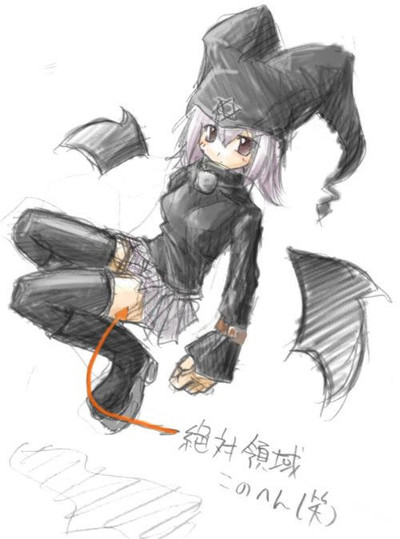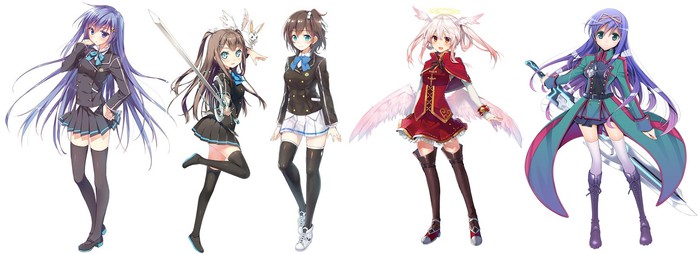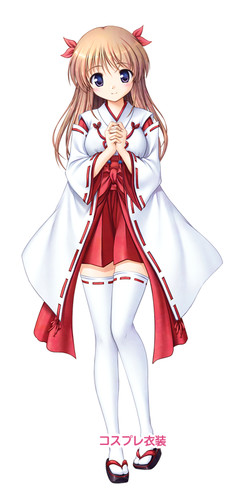What is the "Absolute Territory"?
by Eric Stimson, Anime is rife with fanservice, which often means pandering to fans' favorite fetishes. Some are fads that burst onto the scene and then fade without ever really disappearing, like maids 15 years ago, catgirls 20 years ago, and perhaps little sisters now. Others are character types or story elements so ubiquitous that they've become mascots for anime as a whole, like giant robots or high school girls in sailor uniforms. These fetishes are (in)famous among the otaku community and even outside it, so they often generate debate and discussion. But one of the most prevalent fetishes of the millennium has managed to fly under the radar, relatively unremarked on for years despite littering Japanese visual media. That's because, as fetishes go, it's pretty subtle.
Anime is rife with fanservice, which often means pandering to fans' favorite fetishes. Some are fads that burst onto the scene and then fade without ever really disappearing, like maids 15 years ago, catgirls 20 years ago, and perhaps little sisters now. Others are character types or story elements so ubiquitous that they've become mascots for anime as a whole, like giant robots or high school girls in sailor uniforms. These fetishes are (in)famous among the otaku community and even outside it, so they often generate debate and discussion. But one of the most prevalent fetishes of the millennium has managed to fly under the radar, relatively unremarked on for years despite littering Japanese visual media. That's because, as fetishes go, it's pretty subtle.
Zettai ryōiki (ZR) refers to the strip of skin between a miniskirt and thigh-high stockings. The term means “absolute territory” and originated, like many staples of otaku culture, in Neon Genesis Evangelion; the AT Fields that Evas and Angels can project were translated into Japanese as “Absolute Terror Territory,” or just “absolute territory” for short. Its second meaning entered otaku discourse via a contributor to Ukagaka, an online platform that provides moe girls as on-screen desktop support and was popular around the turn of the millennium. The blog post gushed about Mayura, an Ukagaka character, including the line, “As I've said before, the area between the miniskirt and knee socks is invincible. You could even say it's a holy Absolute Territory!”

Even if that's where the moniker came from, I won't pretend that Mayura opened the floodgates of zettai ryōiki. It predates that March 2001 blog post; miniskirts and high socks are popular in Japan, so combining them isn't anything revolutionary. (This article will use the term zettai ryōiki to refer to the clothing combination, not necessarily the strip of skin per se.) It can be seen in older anime, like Kimagure Orange Road, Ranma ½, Case Closed and Card Captor Sakura. But even then, it was rarely sported as part of a major character's design. From 2001 on, ZR became more and more prevalent in Japanese visual media. Rin from Fate/stay night is usually cited as a major factor in popularizing the look because she combines ZR with a tsundere personality. A series of characters played by Rie Kugimiya in the mid-'00s, like Shana (Shakugan no Shana), Louise (The Familiar of Zero) and Taiga (Toradora!) further cemented ZR's connection with tsundere.

How did zettai ryōiki come to be associated with tsundere? I think the clothing combination symbolizes the character type's personality contradictions. A tsundere is so-called because she is tsun-tsun (aloof and hostile), yet also dere-dere (sweet and caring), depending on the situation. To look at it another way, she is alternately “closed” and “open” to others. Similarly, wearing a miniskirt suggests that a character is “open” and friendly, perhaps unafraid of her sexuality. (Notice how the awkward Tomoko in WATAMOTE wears a comparatively long skirt, or how Chiaki in this season's Gamers! significantly shortens her skirt when she goes through her “transformation” into a more sociable person.) But tsundere aren't unconditionally friendly, so they approach others with suspicion. Hence the high stockings: they aren't about to flaunt their bare legs for the whole world to see. They'll just leave a small strip at the top as a sort of tease – possibly leaving open the chance of a panty shot if it's that kind of show.
Zettai ryōiki continues to be the quickest visual shorthand in anime for tsundere (with twintails in close second). Throughout the last decade, tsundere have followed Rin's lead and adopted ZR, like Hime in Yozakura Quartet, Yuri in Angel Beats!, Houki in Infinite Stratos, Asuna (in multiple avatars) in Sword Art Online, and Yukino in My Teen Romantic Comedy SNAFU. Tsundere flaunting ZR in more recent anime include Chitoge in Nisekoi, Erina in Food Wars!, Julis in The Asterisk War, Emilia in Re:Zero, and this season's standoffish Suzune in Classroom of the Elite.

But zettai ryōiki has become bigger than just a sign of tsundere. Its appeal in character design is wide enough that a greater variety of anime girls now wear it, to the extent that it's basically a coin flip whether seeing a character in ZR means they're tsundere. They can be hyperactive cuties, like the title character in Nyaruko; they can be shy but nice, like Tafumi in New Game!; they can be kind brainiacs, like Emma in The Legend of Heroes: Trails of Cold Steel. Often they play the role of the character that the male lead is steered into ending up with most. Examples of this include Tomoyo in When Supernatural Battles Become Commonplace, Mizuki in Classroom Crisis, and Rimi in Chaos;HEAd (and Serika in its sequel, Chaos;Child). Asuna may start out very tsun-tsun, but for most of SAO she's practically a paragon of The Ideal Girlfriend. The title character in Himouto! Umaru-chan may be a lazy slob at home, but at school she works hard to maintain her image as The Perfect Girl. And what does she wear? You guessed it, ZR. Heck, even when she dons her alter ego, “UMR” the fearsomely skilled gamer, she wears ZR (albeit with short shorts).

Why zettai ryōiki has become common among more friendly characters is a little harder to explain. The simplest explanation would just be that it's popular, and therefore character designers try to use it more, even for characters with broader appeal than tsundere, who can be divisive and obnoxious. But I would argue that the visual symbolism of ZR can be applied to other character types too. ZR-wearing characters tend to be Goldilocks figures: not too hot, not too cold. They're nice and friendly enough to be easy to like, but not cutesy and saccharine to reflect the worst moe clichés. They have an edge or act somewhat reserved, but not to the haughty extent of the ojō-sama characters most likely to cover their whole legs. In other words, their personalities hit the sweet spot where the widest array of viewers are most likely to be drawn to them.

Zettai ryōiki is most closely associated with schoolgirl uniforms, because miniskirts are de rigueur for high school girls in anime, and given the uniformity of uniforms, sock length is one of the few ways girls can modify their appearance. But high school uniform fashion has spread beyond high school anime. Sci-fi anime with futuristic settings can use ZR (like The Asterisk War, Infinite Stratos, or Gundam Seed Destiny). Fantasy anime with swords-‘n’-sorcery trappings can also trot it out – it's a staple of fantasy-themed video games like Fire Emblem and Summon Night, and it's worn by several characters in Is It Wrong to Try to Pick Up Girls in a Dungeon?, Konosuba, and Grimgar of Fantasy and Ash. (Of course, many sci-fi and fantasy anime dress their characters up in clothes that strongly resemble high school uniforms, either because they're in an alternate high school setting or because that look has permeated otaku culture so thoroughly.) ZR's prevalence in RPGs has rubbed off on today's hottest fad, the isekai (fantasy world) genre, and just about any of these shows will have at least one character sporting ZR, usually the female lead. Most isekai works originate as light novels, and light novels in particular are obsessed with ZR, and there are endless examples of light novel covers with energetic girls flaunting their short skirts and high socks.

Girls in fantasy and sci-fi works tend to wear zettai ryōiki because it's associated with one more archetype: the Action Girl. Action Girls have a long pedigree in anime-related fiction, but on the condition that they wear the sorts of clothes that real Action Girls probably wouldn't sally forth into battle wearing. Some anime embrace this aesthetic and have characters kick ass while dressed like strippers, but others opt for slightly more practicality. Thus the high stockings (or sometimes boots). Still, in Japan, a miniskirt at least is essential. (Sometimes you can get away with short shorts.) Whether performing spinning kicks and high jumps wearing a short skirt is such a good idea is questionable, but it's still extremely rare to see Action Girls wearing pants. Sometimes the character design incorporates tighter skirts or long coats over their ZR to minimize the chance of exposure.

There's also a bit of visual symbolism at work for the Action Girl. The high stockings indicate that the character means business and is at least a little tough, while the miniskirt suggests that she still has a strong feminine side. It's basically just a variation on the tsundere personality combination, and wouldn't you know it, a lot of Action Girls are also tsundere.

Zettai ryōiki is definitely a fetish, which is evident by how it's often framed: girls wear it front-and-center on light novel and manga covers, often with the “camera” placed awfully low. The Toradora! opening lovingly includes a shot of Taiga slipping on a sock. Some anime seem particularly dedicated to it, including a cast full of ZR-wearing characters (Ange Vierge, Demon King Daimao, School Days). There are image boards devoted to ZR, including a subreddit. There are stories circulating online about skirts that light up the upper thighs and girls who put ads there because that's where the eye is drawn to, although I doubt these are common practices.

But as far as fetishes go, zettai ryōiki is a subtle one. Because girls can wear it without showing much skin at all, it's considered quite conservative. Sure, you can strike a suggestive pose with ZR or position a camera for easy panty shots, but you can also ignore this and just show a character wearing it casually. Plenty of ZR shows up outside of fanservice anime where it is not framed sexually, so the fashion has become baked into the Japanese pop culture milieu over the past decade. Phenomena with wide fanbases like Love Live! and Vocaloid use it all the time. It's also seeped into wholesome kids' anime, like Pokemon, Digimon, and MegaMan NT Warrior. When video games give players a choice between male and female characters, the female option will often be wearing ZR, perhaps because designers want to keep the characters looking as similar in wardrobe without putting the girls in pants just like the boys. When Nintendo finally provided a female counterpart to Link in The Legend of Zelda, she was inevitably sporting ZR (albeit with boots).

Zettai ryōiki is commonly worn in Japan in real life, perhaps because it's seen as “cute” or “sexy” without being controversial, but I also got the sense that it's not as prevalent in Japan as anime might have you believe. Regardless, it's very much a Japanese trend; while not unheard of overseas (Ariana Grande is a fan, for instance), it's certainly rare. It's also quite rare in shōjo, indicating that the look is considered to be aimed more at male viewers. (Even magical girl shows that frequently use ZR, like Madoka Magica and Yuki Yuna, are more male-aimed in nature.) On that note, it's not unheard of for men to don ZR with shorts (T.M.Revolution wears it in concerts), but for the most part, male legs have never been fetishized to the same extent, whether they're wearing ZR or not.

As a fetish, zettai ryōiki taps into the same sort of less-is-more mentality that led Victorian men to get hot and bothered at the sight of a woman's ankle. Just as eating a panful of brownies in one sitting isn't a good idea no matter how rich and scrumptious they are, gazing at room after room of bare 2D girls' legs in Akihabara can inure otaku to the sight after a while. ZR covers them up, focusing attention on what most men consider the most important part: that which is closest to the “forbidden zone.” At the same time, it's a modest fashion choice by most standards, and I doubt most non-otaku would really notice ZR unless it was visually emphasized by the material. It will be interesting to see whether ZR is a passing fad or a permanent addition to anime's visual vocabulary. If I had to guess, I would predict that it will be looked back on as a fad of the early 21st century, but it will still come up in character designs of the future due to its many aesthetic advantages.

So what do you think of this "absolute territory?" Share your favorite ZR-wearing heroines with us in the forums!
discuss this in the forum (58 posts) |
this article has been modified since it was originally posted; see change history